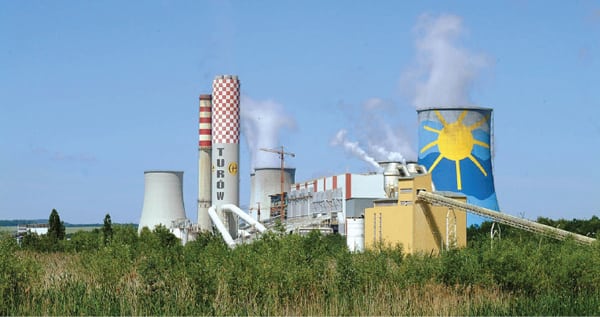Poland, a country that currently depends on coal power for nearly 85% of its electricity and plans to build another 11,300 MW of new coal-fired capacity by 2020, suffered a critical planning setback in mid-July as the European Union (EU) effectively blocked the country from using free carbon emission permits to build new coal-fired power plants. The European Commission’s ruling could mean that Polish coal and lignite generators will face cash flow pressure and profit margin erosion over the next several years, experts suggest.
The EU’s December 2008-initiated Emissions Trading System (ETS) seeks to push companies to invest in low-carbon technologies by setting a carbon cap and then allocating or selling companies allowances to emit carbon dioxide. Under the program’s rules, all power producers must pay for emissions allowances after 2012. The rule’s “10c derogation” article, however, allows 10 newer EU member countries—Bulgaria, Cyprus, Czech Republic, Estonia, Hungary, Latvia, Lithuania, Malta, Poland, and Romania—to claim exemptions and apply for free tradable allowances for power plants that were planned, or whose investment process was “physically initiated,” before the ETS became effective in 2008. The article was intended to help the countries, many of which are from the former eastern bloc, to modernize their energy infrastructure.
Poland had claimed free allowances for 30 coal and natural gas facilities that were proposed or under construction, citing the “10c derogation,” but concerns raised by environmental groups that at least 13 of these were “ghost plants”—projects that had raised investment but not yet been initiated—prompted the EU to reconsider. The groups argued that Poland could use the free emissions permits to make the investment case for the plants, essentially undercutting the ETS’s goal of reducing carbon emissions. In July, the European Commission agreed, ruling that the plants could not use the value of free allocation to fund their own construction and blocked what is thought to be a “substantial number” of investment programs from receiving free allowances.
Poland’s government has planned investments of nearly €7.1 billion ($8.8 billion) to secure the country’s energy supplies through 2030, taking into consideration that almost 7 GW (or 20%) of current coal capacity will have to be phased out by 2015 (Figure 3). The plan calls for fossil fuel–fired power to make up 74% of the country’s generation mix; nuclear, 10%; and renewables, 15%.
 |
| 3. Counting on coal. Poland relies on coal power for 85% of its power needs, and plans call for construction of 11,300 MW of new coal capacity by 2020. But two-thirds of installed coal capacity is older than 30 years—including PGE’s 2.1-GW Turów plant, shown here—and under European Union rules, almost 7 GW will need to be phased out by 2015. PGE undertook a $1.6 billion modernization in the early 1990s of the 1971-built Turów plant, which is situated near a border Poland shares with the Czech Republic and Germany. Courtesy: PGE |
Polish decision-makers have continued to aggressively pursue an energy future where coal power is dominant because the country’s economy thrives on its coal industry: As well as being the ninth-largest hard coal producer in the world, it is the largest in the EU. The country has rejected the EU’s vision for a low-carbon future, which aims for an 80% to 95% cut in Europe’s carbon dioxide emissions by 2050.
But according to Fitch Ratings, Polish utilities—particularly the nation’s four largest ones, PGE Polska Grupa Energetyczna (PGE), Tauron Polska Energia, ENEA, and Energa—will see diminishing profits as a result of a gradual auctioning of carbon allowances from 2013 through 2020, finalization of compensation payments for the termination of power purchase agreements, and an ensuing rising share of renewable energy in the country’s generation mix. Fitch says that the European Commission’s ruling could require Polish utilities to buy about 50% of their annual carbon allowances, compared to just about 10% in 2012. “This translates into additional cash operating costs of PLN1.7 billion [€410 million, $509.22 million] for the Polish power sector in 2013 based on the average CO2 price for [the first quarter of 2012]. Fitch assumes in its projections that this additional cost for utilities will not be fully passed on to customers and margins will suffer as a result.”
Utilities like PGE, which have a “competitive advantage” because of its dominant position in generation, a relatively younger coal fleet, and lower-than-average power production costs owing to its lignite plants, may be less affected than its peers, Fitch suggests. Polish grid operator PSE Operator, meanwhile, may offer financial relief to owners of plants that could be needed to ensure reliability; PSE currently covers variable costs, including 100% of carbon dioxide costs for such production. Poland’s grid is relatively isolated, given its limited interconnection capability, the agency noted.
—Sonal Patel is POWER’s senior writer.










